Abstract
Metallothioneins are a group of low-molecular-weight intracellular proteins present in high levels in fetal mammalian livers, bound to zinc and copper. They are also present in two major isoforms in low basal levels in various organs of adults in several species. Although a number of functions have been proposed for metallothioneins, their major biological roles may be in the storage of zinc and copper during rapid growth and development, and also in the detoxification of certain toxic metals. In adult liver, metallothionein is mainly localized in the cytoplasm, it is localized also in the hepatocyte nuclei in human fetal liver and fetal and neonatal rat liver, as determined by immunohistochemical staining with a specific metallothionein antibody. Because of its high expression in fetal development, the potential role of metallothioneins in human tumors was investigated. The cellular localization of metallothionein was demonstrated in various human tumors such as thyroid tumors, testicular germ cell carcinoma, bladder transitional cell carcinomas, and salivary gland tumors. In most of these tumor tissues, metallothioneins were found in high levels in nucleus and cytoplasm in both benign and malignant tumors, although the proliferating edge of the malignant tumors showed most intense metallothionein staining. The expression of metallothionein is not universal to all tumor growth; its presence may depend on various factors, such as the type of tumor, cellular origin, morphological heterogeneity, or stage of growth. Human testicular seminomas, which are well differentiated, showed little expression of metallothionein irrespective of the staging, as compared to less well-differentiated embryonal carcinomas.(ABSTRACT TRUNCATED AT 250 WORDS)
Full text
PDF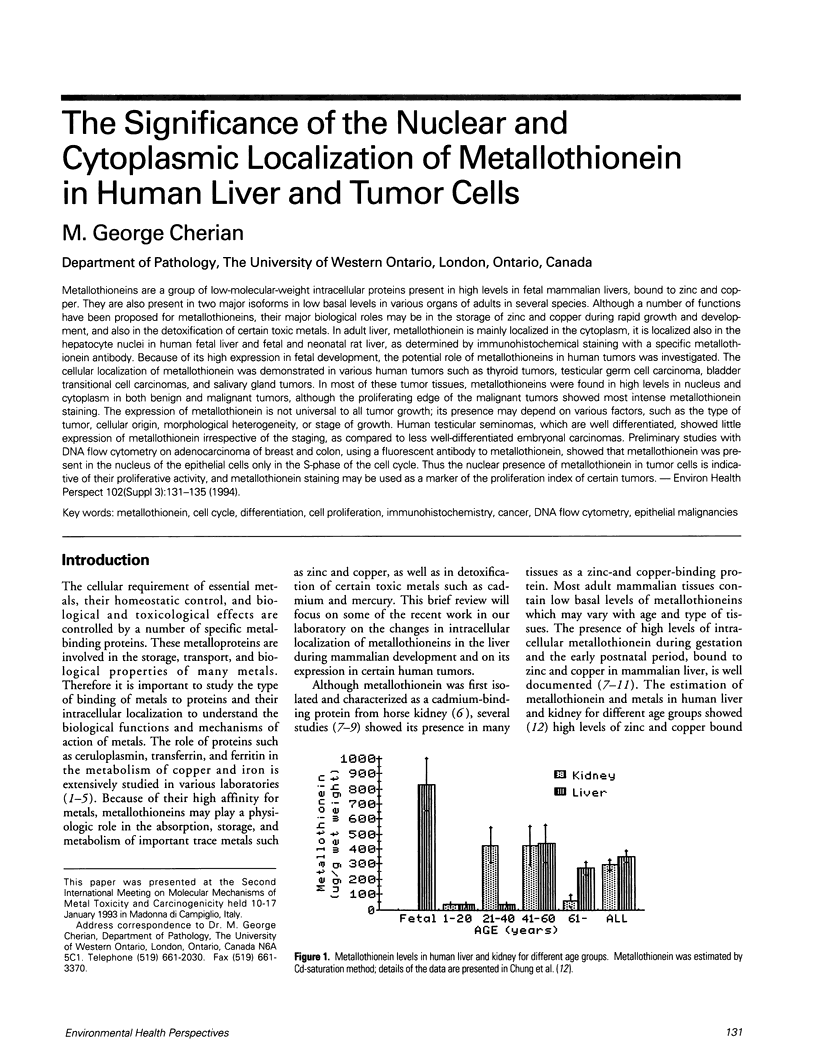
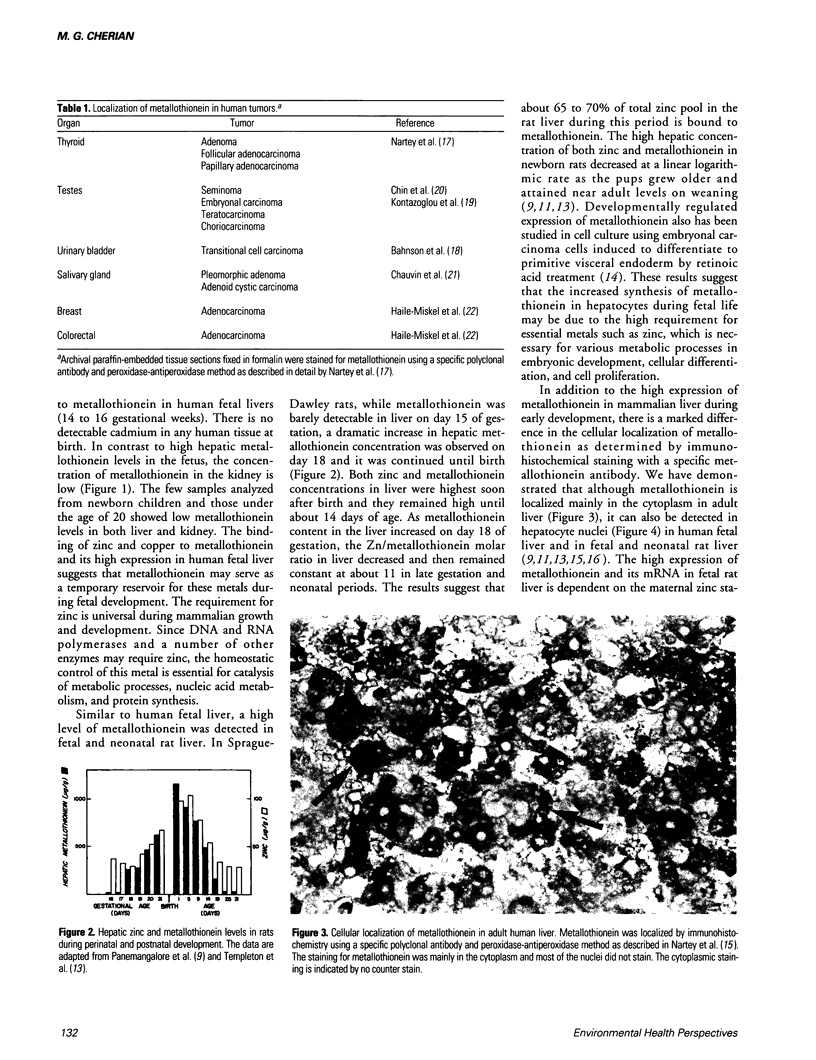
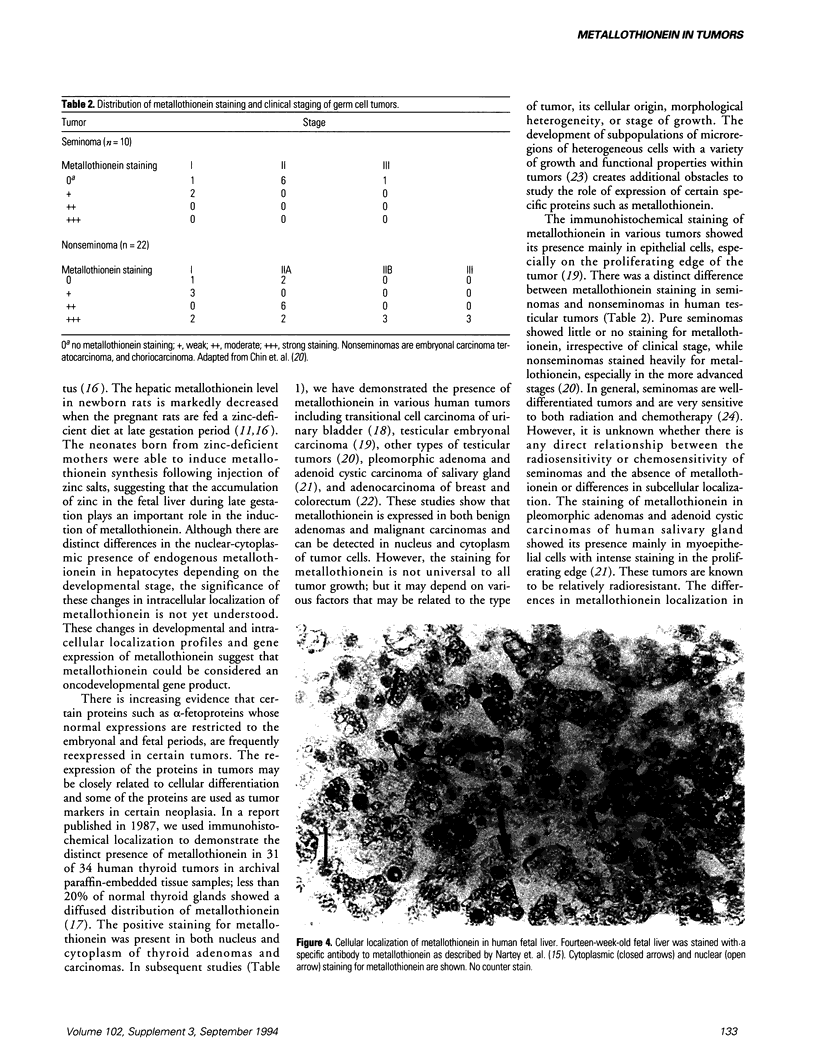
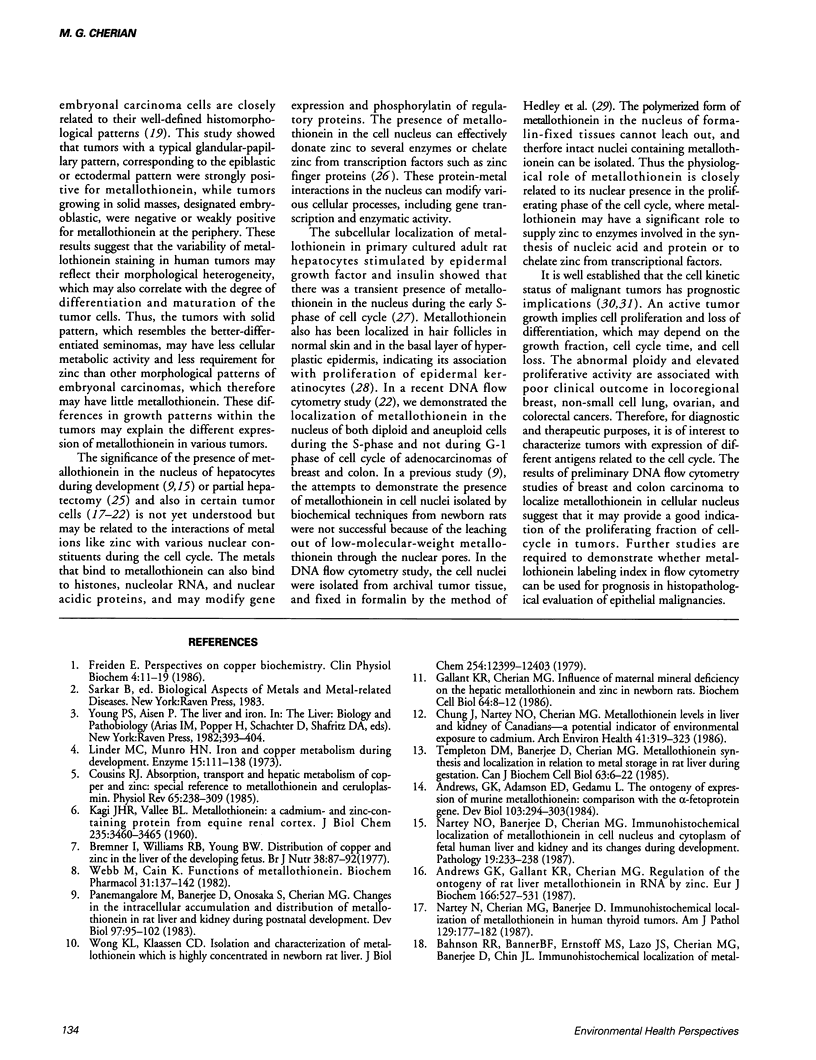
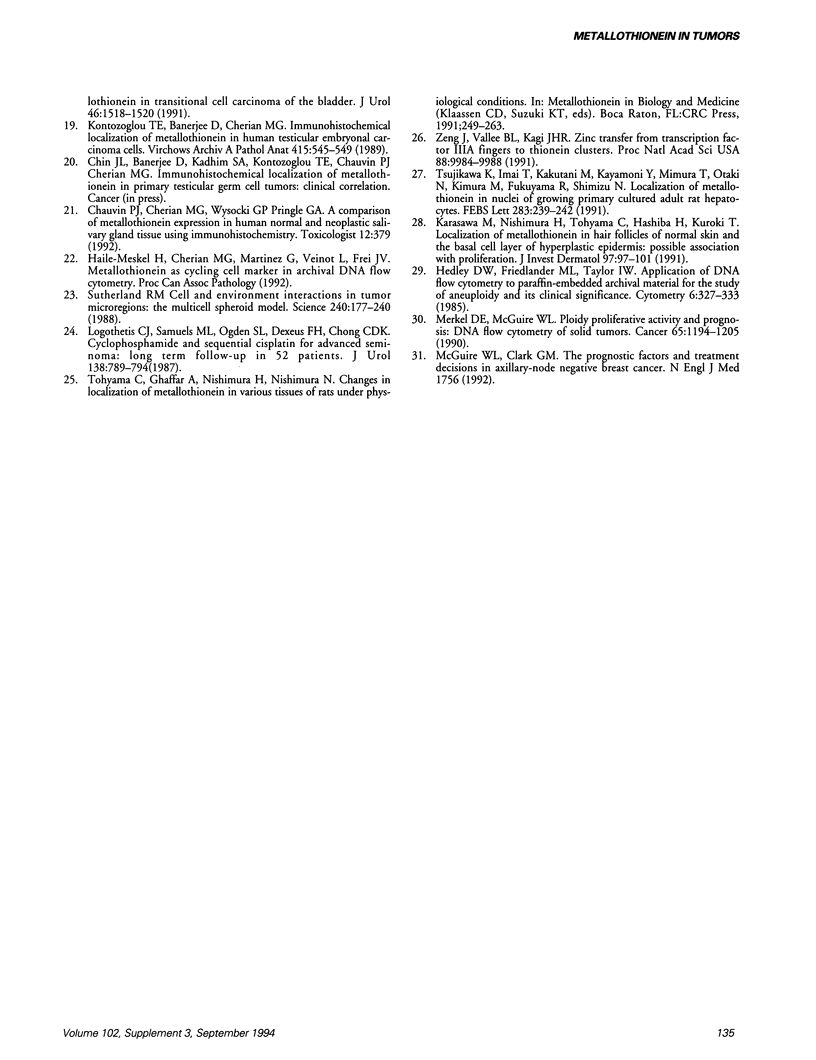
Images in this article
Selected References
These references are in PubMed. This may not be the complete list of references from this article.
- Andrews G. K., Adamson E. D., Gedamu L. The ontogeny of expression of murine metallothionein: comparison with the alpha-fetoprotein gene. Dev Biol. 1984 Jun;103(2):294–303. doi: 10.1016/0012-1606(84)90317-8. [DOI] [PubMed] [Google Scholar]
- Andrews G. K., Gallant K. R., Cherian M. G. Regulation of the ontogeny of rat liver metallothionein mRNA by zinc. Eur J Biochem. 1987 Aug 3;166(3):527–531. doi: 10.1111/j.1432-1033.1987.tb13545.x. [DOI] [PubMed] [Google Scholar]
- Bahnson R. R., Banner B. F., Ernstoff M. S., Lazo J. S., Cherian M. G., Banerjee D., Chin J. L. Immunohistochemical localization of metallothionein in transitional cell carcinoma of the bladder. J Urol. 1991 Dec;146(6):1518–1520. doi: 10.1016/s0022-5347(17)38155-7. [DOI] [PubMed] [Google Scholar]
- Bremner I., Williams R. B., Young B. W. Distribution of copper and zinc in the liver of the developing sheep foetus. Br J Nutr. 1977 Jul;38(1):87–92. doi: 10.1079/bjn19770064. [DOI] [PubMed] [Google Scholar]
- Chung J., Nartey N. O., Cherian M. G. Metallothionein levels in liver and kidney of Canadians--a potential indicator of environmental exposure to cadmium. Arch Environ Health. 1986 Sep-Oct;41(5):319–323. doi: 10.1080/00039896.1986.9936704. [DOI] [PubMed] [Google Scholar]
- Cousins R. J. Absorption, transport, and hepatic metabolism of copper and zinc: special reference to metallothionein and ceruloplasmin. Physiol Rev. 1985 Apr;65(2):238–309. doi: 10.1152/physrev.1985.65.2.238. [DOI] [PubMed] [Google Scholar]
- Frieden E. Perspectives on copper biochemistry. Clin Physiol Biochem. 1986;4(1):11–19. [PubMed] [Google Scholar]
- Gallant K. R., Cherian M. G. Influence of maternal mineral deficiency on the hepatic metallothionein and zinc in newborn rats. Biochem Cell Biol. 1986 Jan;64(1):8–12. doi: 10.1139/o86-002. [DOI] [PubMed] [Google Scholar]
- Hedley D. W., Friedlander M. L., Taylor I. W. Application of DNA flow cytometry to paraffin-embedded archival material for the study of aneuploidy and its clinical significance. Cytometry. 1985 Jul;6(4):327–333. doi: 10.1002/cyto.990060409. [DOI] [PubMed] [Google Scholar]
- KAGI J. H., VALEE B. L. Metallothionein: a cadmium- and zinc-containing protein from equine renal cortex. J Biol Chem. 1960 Dec;235:3460–3465. [PubMed] [Google Scholar]
- Karasawa M., Nishimura N., Nishimura H., Tohyama C., Hashiba H., Kuroki T. Localization of metallothionein in hair follicles of normal skin and the basal cell layer of hyperplastic epidermis: possible association with cell proliferation. J Invest Dermatol. 1991 Jul;97(1):97–100. doi: 10.1111/1523-1747.ep12478393. [DOI] [PubMed] [Google Scholar]
- Kontozoglou T. E., Banerjee D., Cherian M. G. Immunohistochemical localization of metallothionein in human testicular embryonal carcinoma cells. Virchows Arch A Pathol Anat Histopathol. 1989;415(6):545–549. doi: 10.1007/BF00718648. [DOI] [PubMed] [Google Scholar]
- Linder M. C., Munro H. N. Iron and copper metabolism during development. Enzyme. 1973;15(1):111–138. [PubMed] [Google Scholar]
- Logothetis C. J., Samuels M. L., Ogden S. L., Dexeus F. H., Chong C. D. Cyclophosphamide and sequential cisplatin for advanced seminoma: long-term followup in 52 patients. J Urol. 1987 Oct;138(4):789–794. doi: 10.1016/s0022-5347(17)43376-3. [DOI] [PubMed] [Google Scholar]
- Merkel D. E., McGuire W. L. Ploidy, proliferative activity and prognosis. DNA flow cytometry of solid tumors. Cancer. 1990 Mar 1;65(5):1194–1205. doi: 10.1002/1097-0142(19900301)65:5<1194::aid-cncr2820650528>3.0.co;2-m. [DOI] [PubMed] [Google Scholar]
- Nartey N. O., Banerjee D., Cherian M. G. Immunohistochemical localization of metallothionein in cell nucleus and cytoplasm of fetal human liver and kidney and its changes during development. Pathology. 1987 Jul;19(3):233–238. doi: 10.3109/00313028709066555. [DOI] [PubMed] [Google Scholar]
- Nartey N., Cherian M. G., Banerjee D. Immunohistochemical localization of metallothionein in human thyroid tumors. Am J Pathol. 1987 Oct;129(1):177–182. [PMC free article] [PubMed] [Google Scholar]
- Panemangalore M., Banerjee D., Onosaka S., Cherian M. G. Changes in the intracellular accumulation and distribution of metallothionein in rat liver and kidney during postnatal development. Dev Biol. 1983 May;97(1):95–102. doi: 10.1016/0012-1606(83)90067-2. [DOI] [PubMed] [Google Scholar]
- Sutherland R. M. Cell and environment interactions in tumor microregions: the multicell spheroid model. Science. 1988 Apr 8;240(4849):177–184. doi: 10.1126/science.2451290. [DOI] [PubMed] [Google Scholar]
- Templeton D. M., Banerjee D., Cherian M. G. Metallothionein synthesis and localization in relation to metal storage in rat liver during gestation. Can J Biochem Cell Biol. 1985 Jan;63(1):16–22. doi: 10.1139/o85-003. [DOI] [PubMed] [Google Scholar]
- Tsujikawa K., Imai T., Kakutani M., Kayamori Y., Mimura T., Otaki N., Kimura M., Fukuyama R., Shimizu N. Localization of metallothionein in nuclei of growing primary cultured adult rat hepatocytes. FEBS Lett. 1991 Jun 3;283(2):239–242. doi: 10.1016/0014-5793(91)80597-v. [DOI] [PubMed] [Google Scholar]
- Webb M., Cain K. Functions of metallothionein. Biochem Pharmacol. 1982 Jan 15;31(2):137–142. doi: 10.1016/0006-2952(82)90202-7. [DOI] [PubMed] [Google Scholar]
- Wong K. L., Klaassen C. D. Isolation and characterization of metallothionein which is highly concentrated in newborn rat liver. J Biol Chem. 1979 Dec 25;254(24):12399–12403. [PubMed] [Google Scholar]
- Zeng J., Vallee B. L., Kägi J. H. Zinc transfer from transcription factor IIIA fingers to thionein clusters. Proc Natl Acad Sci U S A. 1991 Nov 15;88(22):9984–9988. doi: 10.1073/pnas.88.22.9984. [DOI] [PMC free article] [PubMed] [Google Scholar]




